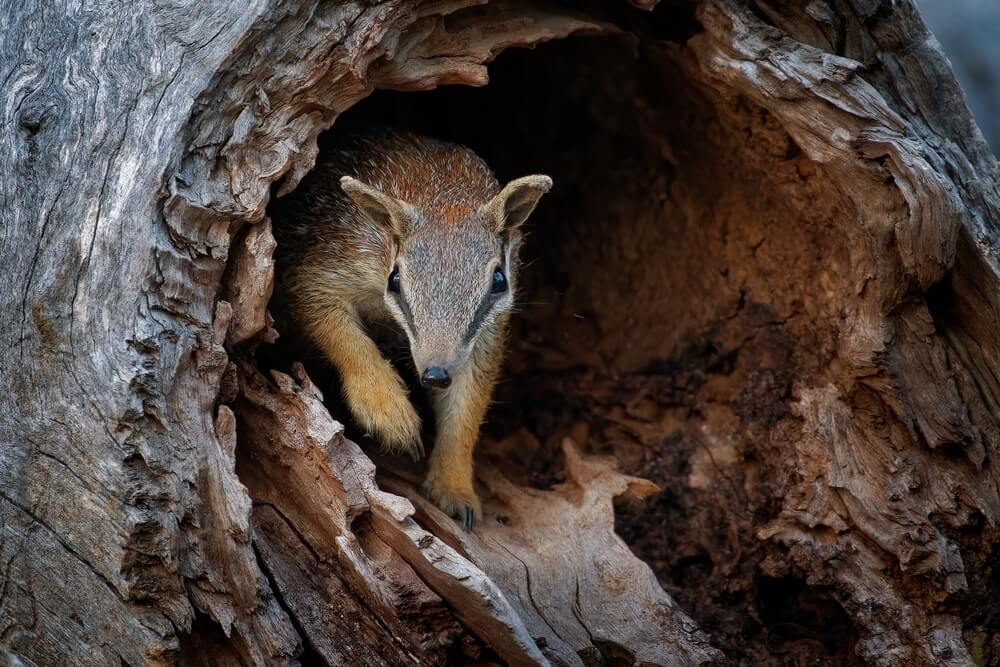Hello Everyone, Did you know that there are some incredible creatures out there whose names start with the letter ‘N’? While we may be familiar with popular animals like the lion or the eagle, there are many lesser-known species that deserve our attention. In this article, we will take you on a journey to discover the hidden gems of the animal kingdom, unveiling five fascinating creatures that start with the letter ‘N’.Our first stop on this expedition is the Nile crocodile, a fearsome reptile known for its powerful jaws and incredible agility.
Next on the list is the numbat, a small marsupial native to Western Australia, known for its distinct striped coat and its love for termites. Moving on, we will encounter the Narwhal, an Arctic whale famous for its long, spiraled tusk. Then, we will meet the Nudibranch, a colorful sea slug with intricate patterns and shapes. Finally, we will discover the Numbat, a pint-sized anteater with a sweet tooth for ants. Join us as we delve into the fascinating world of these lesser-known creatures beginning with ‘N’. Get ready to be amazed by the incredible diversity and beauty of the animal kingdom!
Importance of exploring lesser-known animals
Exploring lesser-known animals is not only an exciting adventure but also an important way to expand our understanding of the natural world. By shining a spotlight on these creatures, we can raise awareness about their existence and the unique roles they play in their ecosystems. It is through this exploration that we can truly appreciate the incredible diversity and beauty of the animal kingdom. So, let’s dive into the fascinating world of these lesser-known creatures beginning with ‘N’, and discover what makes them so special.
Animals that start with ‘N’ – a brief overview
Before we delve into the details of each animal, let’s take a moment to get acquainted with the five incredible creatures that we will be exploring. From the marsupials of Australia to the whales of the Arctic, these animals represent a wide range of species and habitats. So, without further ado, let’s meet our hidden gems:
Numbat – The Termite-Eating Marsupial

The Numbat, also known as the banded anteater, is a small marsupial native to Western Australia. With its distinct striped coat and bushy tail, it is a creature that stands out in the wild. But what truly sets the Numbat apart is its diet. Unlike other marsupials, the Numbat is exclusively insectivorous, with a particular fondness for termites. With its long, sticky tongue, it can slurp up thousands of termites in a single feeding session. This unique adaptation has earned it the nickname “nature’s vacuum cleaner.” However, despite its fascinating lifestyle, the Numbat faces numerous threats, including habitat loss and predation. Conservation efforts are crucial to ensure the survival of this remarkable creature.
Nudibranch – The Flamboyant Sea SlugIf you thought slugs were dull and uninteresting, think again!
The Nudibranch, a type of sea slug, is anything but ordinary. With its vibrant colors and intricate patterns, it is a true masterpiece of nature. These flamboyant creatures can be found in oceans around the world, from the tropics to the Arctic. What makes the Nudibranch even more fascinating is its ability to incorporate toxins from its prey into its own body, making it unpalatable to potential predators. This defense mechanism, combined with its striking appearance, has made the Nudibranch a favorite subject for underwater photographers and marine enthusiasts alike.
Nyala – The Elusive African Antelope
The Nyala is a majestic antelope species native to southern Africa. With its long spiral horns and beautiful coat, it is a sight to behold. But what makes the Nyala truly captivating is its elusive nature. Preferring dense vegetation and thickets, it is often difficult to spot in the wild. The males, in particular, are known for their territorial displays, which involve rubbing their scent glands on trees and bushes to mark their territory. These displays, accompanied by their haunting calls, add to the allure of this remarkable antelope. However, habitat loss and poaching pose significant threats to the Nyala population, making conservation efforts essential for its survival.
Nene – The Hawaiian GooseThe Nene, also known as the Hawaiian goose, is a symbol of the Hawaiian Islands and a conservation success story.
Endemic to Hawaii, this goose species was once on the brink of extinction, with only 30 individuals remaining in the 1950s. Thanks to intensive conservation efforts, the population has since rebounded, reaching over 2,800 individuals today. The Nene is well adapted to its island habitat, with specialized feet for traversing lava fields and a unique diet of grasses and shrubs. Its distinctive honking call can be heard echoing across the volcanic landscapes, a reminder of the resilience of this remarkable bird.
Nighthawk – The Aerial InsectivoreAs the name suggests, the Nighthawk is a bird that comes alive at night.
These aerial insectivores are known for their acrobatic flight patterns and their ability to catch insects on the wing. With their large mouths and wide gapes, they are well-equipped for their nighttime feeding habits. During the day, they can be found perched on tree branches or hidden in plain sight, blending in with their surroundings. The Nighthawk’s unique adaptations and nocturnal lifestyle make it a fascinating creature to observe and study.
Numbat – The termite-eating marsupial
Now that we’ve learned about these incredible animals, it’s important to consider how we can support their conservation. Here are a few ways you can make a difference:
1. Educate Yourself and Others: Spread awareness about these lesser-known animals by sharing what you’ve learned with friends, family, and on social media. The more people know about these creatures, the more likely they are to support conservation efforts.
2. Support Local and International Conservation Organizations: Many organizations work tirelessly to protect endangered species and their habitats. Consider donating to or volunteering with these organizations to help fund important research and conservation initiatives.
3. Choose Sustainable and Ethical Products: Make conscious choices when purchasing products derived from animals or their habitats. Look for certifications and labels that indicate sustainable and ethical practices.
4. Advocate for Stronger Environmental Policies: Encourage policymakers to prioritize environmental protection and conservation. Write letters, sign petitions, and engage in discussions to raise awareness about the importance of preserving biodiversity.
Nudibranch – The flamboyant sea slug
The animal kingdom is full of hidden gems waiting to be discovered. By exploring lesser-known animals like the Numbat, Nudibranch, Nyala, Nene, and Nighthawk, we gain a deeper appreciation for the incredible diversity and beauty of the natural world. These creatures teach us valuable lessons about adaptation, resilience, and the delicate balance of ecosystems. So, let’s continue to unveil these hidden gems and ensure their survival for generations to come. Together, we can make a difference in the conservation of our planet’s precious wildlife.
Nyala – The elusive African antelope
The first hidden gem we are going to explore is the Nudibranch, a flamboyant sea slug that is sure to captivate your attention. Found in oceans around the world, these colorful creatures display an astonishing array of patterns and shapes on their bodies. Unlike their name suggests, nudibranchs are not actually slugs, but rather a type of marine gastropod mollusk.Nudibranchs come in a wide range of sizes, from just a few millimeters to several centimeters long. Their vibrant colors are not just for show; they serve as a warning to potential predators that they are toxic or distasteful. These beautiful creatures have evolved an ingenious defense mechanism by feeding on poisonous marine organisms like sponges and hydroids, which they incorporate into their own tissues.One of the most fascinating aspects of nudibranchs is their ability to undergo rapid color changes. This is achieved through the redistribution of pigments within their skin cells. Scientists believe that this remarkable adaptation helps them blend in with their surroundings or communicate with other nudibranchs. With over 3,000 known species, each with its own unique appearance, exploring the world of nudibranchs is like diving into a kaleidoscope of colors and shapes.
Nene – The Hawaiian goose
Our next hidden gem takes us to the plains of Africa, where we encounter the Nyala, an elusive antelope that roams the dense woodlands and thickets. With its striking reddish-brown coat and white vertical stripes on its sides, the Nyala stands out as one of the most beautiful antelopes in the world. The males, known as rams, have long, spiral-shaped horns that can reach up to 85 centimeters in length. These impressive horns not only serve as a symbol of dominance but also provide protection against predators.
In contrast, the females, known as ewes, do not have horns and have a lighter build.Nyala are highly adapted to their habitat, with their large ears and excellent hearing allowing them to detect potential threats from a distance. They are also skilled at camouflage, blending seamlessly into the surrounding vegetation. Their diet consists mainly of leaves, fruits, and grass, making them browsers rather than grazers like many other antelopes.Unfortunately, the Nyala population has been declining due to habitat loss and poaching.
Conservation efforts are crucial to protect these magnificent animals and their habitats. By supporting organizations that work towards preserving their natural environment and enforcing stricter anti-poaching measures, we can help ensure the survival of this enchanting species.
Nighthawk – The aerial insectivore
Our journey now takes us to the beautiful islands of Hawaii, where we encounter the Nene, the official state bird of Hawaii. Also known as the Hawaiian goose, this unique species is endemic to the islands and can be found in both high-altitude volcanic slopes and coastal plains.The Nene is a medium-sized goose with a distinctive appearance.
Its plumage is mostly gray, with a black face, neck, and crown. The males and females look similar, although males are slightly larger. One of the most striking features of the Nene is its distinctive call, which sounds like a soft “nay-nay” or “nay-ay”. This vocalization is often used for communication and to establish territory.
Once on the brink of extinction, the Nene population has made a remarkable recovery thanks to conservation efforts. The introduction of predator control programs and the establishment of protected areas have played a crucial role in their conservation. Today, the Nene serves as a symbol of hope for endangered species recovery and showcases the importance of preserving unique and fragile ecosystems.
How to support conservation efforts for these animals?
Our next hidden gem takes us to the skies, where we encounter the Nighthawk, a fascinating aerial insectivore. Despite its name, the Nighthawk is not actually a hawk, but rather a nocturnal bird that belongs to the nightjar family. These birds are known for their incredible aerial acrobatics and their ability to catch insects on the wing. Nighthawks have a unique appearance, with mottled brown and gray plumage that blends perfectly with their surroundings. They have long, pointed wings and a forked tail, which aids in their agile flight.
These birds are primarily active at dusk and dawn when they venture out to hunt for insects such as moths, beetles, and flying ants. During the breeding season, male Nighthawks perform an elaborate courtship display, known as “booming”. This involves diving towards the ground and then pulling up at the last moment, creating a loud booming sound with their wings. This display serves to attract females and establish territorial boundaries.
Unfortunately, Nighthawks face several threats, including habitat loss, pesticides, and light pollution. The destruction of their natural habitats and the decline of insect populations have had a significant impact on their numbers. To support the conservation of Nighthawks, it is important to create awareness about the importance of preserving their habitats and reducing the use of harmful pesticides.
Also Read:-
- African Wildlife: A Beginner’s Guide to the Big Five
- Top 10 Birds in Africa
- Types of dragons
- Snakes in Kentucky
- Unlocking the Secrets of Bluebirds
Conclusion
Now that we have explored these hidden gems of the animal kingdom, you might be wondering how you can contribute to their conservation. Here are a few ways you can make a difference:
1. Support conservation organizations: There are numerous organizations dedicated to protecting endangered species and their habitats. Consider donating to or volunteering with these organizations to support their efforts.
2. Spread awareness: Share your newfound knowledge about these lesser-known animals with others.
Educate your friends, family, and community about the importance of biodiversity and the need to protect these unique creatures.
3. Practice sustainable living: Make conscious choices in your daily life to reduce your impact on the environment. This can include reducing waste, conserving water, and choosing eco-friendly products.
4. Engage in responsible tourism: When visiting natural habitats, ensure that you follow guidelines and regulations to minimize your impact. Respect wildlife and their habitats by observing from a distance and not disturbing their natural behavior. By taking these simple steps, we can all contribute to the conservation of these fascinating creatures and help preserve the incredible diversity and beauty of the animal kingdom.

